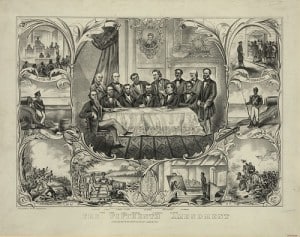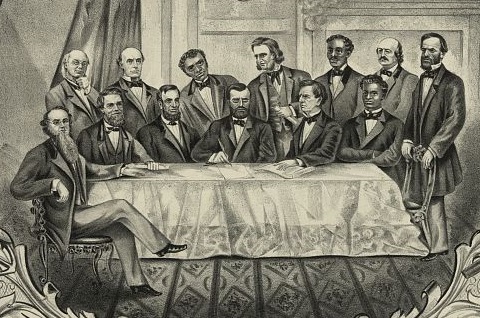African American History, California History
Napa County and the 15th Amendment
On March 30, 1870, just five years after the end of the Civil War, the Fifteenth Amendment was ratified, granting all citizens the right to vote regardless of race, ethnicity, or if they had once been enslaved. Philip A. Bell, editor of The Elevator, wrote, “PROGRESS OF LIBERTY! Gloria Triumphe! We are free! The Fifteenth Amendment…has received the ratification of the requisite number of States; and when officially announced by the Secretary of State will become the law of the land and must be obeyed – the special pleadings of Gov. Haight and the fulminations of the Democratic majority of the Legislature of California…to the contrary notwithstanding.”[i]
In Napa, the passing of the Fifteenth Amendment was marked with multiple celebrations. The Napa County Reporter recorded the events in detail, including unnecessary casual racism:
At about noon a couple of anvils were brought into requisition, and made to play the part of a cannon. At or near 1 o’clock in the afternoon the exercises of the day commenced in Hartson’s Hall. Prayer was offered up to the Most High, and was followed by singing. Fred Sparrow acted as President of the day and Joseph Hatton as Vice President. Thomas Gains read the 13th, 14th, and 15th Constitutional Amendments. Music. Then came the oration by Mr. Hillery of San Francisco – a genuine but pretty smart darkey. Hillery is a good speaker, and as he was speaking in behalf of his own race his remarks brought forth the most enthusiastic applause from his colored countryman. Like most darkies Hillery has a full appreciation of the humorous, and besides is something of a wag himself; consequently he kept quiet a crowd in a good humor for some time. We will not refer particularly to his remarks, but [unreadable] say his reflections upon foreigners was entirely out of place, more particularly as there were a number present. If the negro expects to be a good citizen he must not allow prejudice to get the better of him. The festivities of the day passed off agreeably to the colored people, and nothing occurred to mar or interfere with their jollification. In the evening they set a collision in Quinn & Williams Hall, and sang, marched around the room and enjoyed themselves until near midnight.[ii]
 Shortly after the Fifteenth Amendment reaffirmed his rights as an American citizen, Frederick Sparrow, a 27-year-old barber in Napa City, became the first African American to register to vote in the North Bay.[iii] Joseph Hatton, another middle class Black barber, recorded thirty-eight eligible voters in Napa County in November 1869, just prior to ratification: James Anderson, G. W. Ashley, J. H. Baker, William L. Bayley, George W. Bently, James Boadley, A. Brock, George W. Brown, William Brooks, Paul Canner, Richard Canner, Thomas E. Gaines, Hiram Grigsbey, Edward G. Hatton, Joseph S. Hatton, James Holman, Armstead C. Jones, Peter Lancaster, John Moore, James E. Nicholas, Henry Pearsall, Jerry Pearsall, Jerry Preston, Aaron Rice, Nathaniel Rice, Rev. Robert Rice, William Russell, George W. Scott, Abraham Seawell, M. Solaman, Frederick A. Sparrow, John St. Clair, A. F. Starkey, Samuel Starr, Robert Taylor, G. W. Want, James Williams, and John Wright.[iv] Ten of these men appear on no census records for Napa County, differently spelled names notwithstanding. Of the remaining twenty-eight, only six were born free.
Shortly after the Fifteenth Amendment reaffirmed his rights as an American citizen, Frederick Sparrow, a 27-year-old barber in Napa City, became the first African American to register to vote in the North Bay.[iii] Joseph Hatton, another middle class Black barber, recorded thirty-eight eligible voters in Napa County in November 1869, just prior to ratification: James Anderson, G. W. Ashley, J. H. Baker, William L. Bayley, George W. Bently, James Boadley, A. Brock, George W. Brown, William Brooks, Paul Canner, Richard Canner, Thomas E. Gaines, Hiram Grigsbey, Edward G. Hatton, Joseph S. Hatton, James Holman, Armstead C. Jones, Peter Lancaster, John Moore, James E. Nicholas, Henry Pearsall, Jerry Pearsall, Jerry Preston, Aaron Rice, Nathaniel Rice, Rev. Robert Rice, William Russell, George W. Scott, Abraham Seawell, M. Solaman, Frederick A. Sparrow, John St. Clair, A. F. Starkey, Samuel Starr, Robert Taylor, G. W. Want, James Williams, and John Wright.[iv] Ten of these men appear on no census records for Napa County, differently spelled names notwithstanding. Of the remaining twenty-eight, only six were born free.
Voting was practically a sacred act for African Americans, and an incident the following election year shows just how seriously they took it. There were three fights during that particular day of ballot-casting, one of which involved “three of the ‘best’ men of the [Black] community…By very strenuous efforts of bystanders and friends, a serious affray was prevented.”[v] The article went on to describe the circumstances leading to the fracas:
Last Wednesday morning one of our colored citizens assuaged the privilege of voting for a Democrat, and he soon ascertained that he had entered upon a dangerous road, for, on arriving on Main Street where some of his own people were discussing the subject, one of them called him an ugly name and a fight ensued. We didn’t see it, but understand that one of the people received a gash over the eye and a severe bite in the breast. His eye was doubtless black next morning.[vi]
Not everyone in Napa was pleased with African American men having the right to vote. A few months before the aforementioned fight,
the colored voters took a lively interest in the Republican primaries, and one or two of them drained the cap of enthusiasm to the dregs. One of this class engaged in a lively passage of words with a Republican who didn’t like negro suffrage. A third party of foreign descent interfered with a little good advice for the purpose of soothing the angry feelings which were risking and met with the following pungent rebuke: ‘Look yer, Mr. —, dar’s a difference twixt me and you. I’se an American and you’s an Englishman; dat’s the difference.’ Verily, the Star of Empire is moving.[vii]
In the nineteenth century, the right to vote – and the fight to secure the right to vote – was intended as a strictly male activity. Participation in the political process, as Barbara Y. Welke explains, “was a defining rite of manhood. To be excluded from exercising those rights was to be emasculated.”[viii] Black women were excluded from such political activity, but found other ways of pressing for civil rights. While Black men were demanding the rights to vote and to testify in court “as rights of manhood…the right to be a passenger, to sit, to be carried on a streetcar [was] a distinctly female right.”[ix] Yet even the right to travel unencumbered could be framed from the male perspective, as a Black woman turned away from public transport and forced to walk impinged upon her husband’s dignity and made him look like a failed provider.
[Ed. note: this article is excerpted in part from the master’s thesis “There Are No Black People in Napa”: A History of African Americans in Napa County by Alexandria Brown.]
[i] Philip A. Bell, “Progress of Liberty!,” Elevator (San Francisco), February 11, 1870, http://cdnc.ucr.edu/cgi-bin/cdnc?a=d&d=EL18700211.2.9&srpos=1&e=–1850—1900–en–20-EL%2cPA-1–txt-txIN-gloria+triumphe——#.
[ii] “Negro Ratification,” Napa County Reporter, April 16, 1870, microfilm.
[iii] “First,” Elevator (San Francisco), April 15, 1870, http://cdnc.ucr.edu/cgi-bin/cdnc?a=d&d=EL18700415.2.5&srpos=5&e=——-en–20-EL-1–txt-txIN-sparrow——#.
[iv] Philip A. Bell, “Prospective Voters,” Elevator (San Francisco), November 26, 1869, http://cdnc.ucr.edu/cgi-bin/cdnc?a=d&d=EL18691126.2.10&srpos=1&e=–1869—1869–en–20-EL-1–txt-txIN-voters+napa——#.
[v] “Election Fights,” Napa County Reporter, September 9, 1871, microfilm.
[vi] “Color,” Napa County Reporter, September 9, 1871, microfilm.
[vii] “A Difference,” Napa County Reporter, June 24, 1871, microfilm.
[viii] Barbara Y. Welke, “Rights of Passage: Gendered-Rights Consciousness and the Quest for Freedom, San Francisco, California, 1850-1870,” in African American Women Confront the West, 1600-2000, eds. Quintard Taylor and Shirley Ann Wilson Moore (Norman, OK: University of Oklahoma Press, 2003), 75.
[ix] Ibid., 80.


